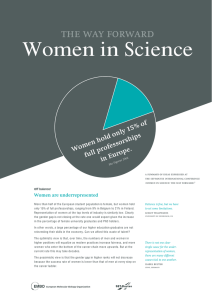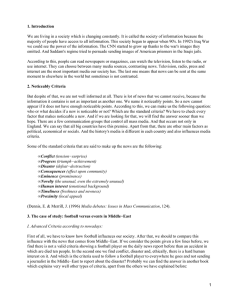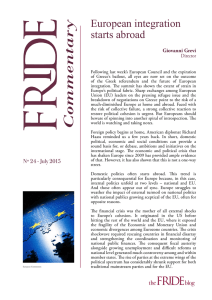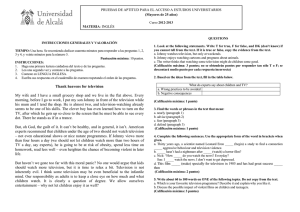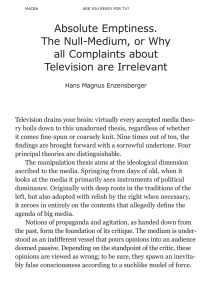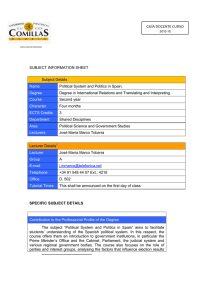Middle East - Agility CMS
Anuncio
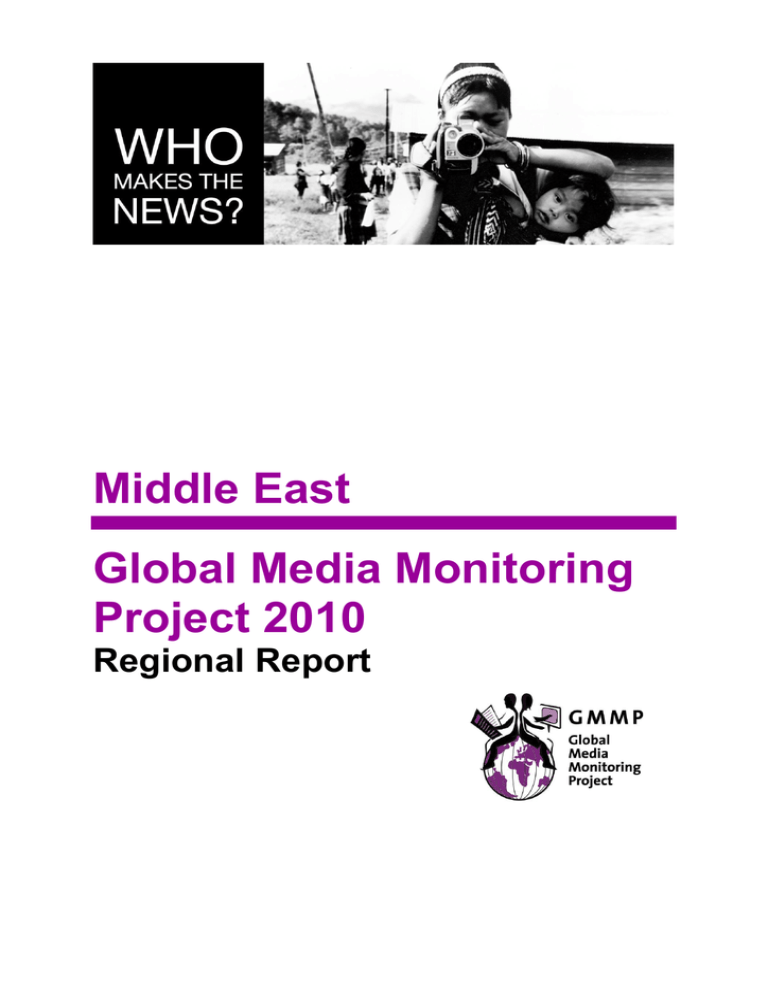
Middle East Global Media Monitoring Project 2010 Regional Report Acknowledgements GMMP 2010 is licensed under creative commons using an Attribution-NonCommercial-NoDerivs. GMMP 2010 is co-ordinated by the World Association for Christian Communication (WACC), an international NGO which promotes communication for social change, in collaboration with data analyst, Media Monitoring Africa (MMA), South Africa. The data for GMMP 2010 was collected through the collective voluntary effort of hundreds of organizations including gender and media activists, grassroots communication groups, academics and students of communication, media professionals, journalists associations, alternative media networks and church groups. Noncommercial. You may not use this work for commercial purposes. No derivative Works. You may not alter, transform, or build upon this work. For any use or distribution, you must make clear to others the license terms of this work. Your fair use and other rights are in now way affected by the above. Appropriate Communication Techniques for Development (ACT) Coptic Evangelical Organization for Social Services (CEOSS) Preface Global Context 10 November 2009 was an ordinary day at work for newsroom staff around the world. It was however a special day for groups in over 100 countries who gathered to monitor their news media. After months of planning, preparations and training, they brought the Fourth Global Media Monitoring Project (GMMP) to life. The Global Media Monitoring Project (GMMP) is the world‟s longest-running and most extensive research on gender in the news media. It began in 1995 when volunteers in 71 countries around the world monitored women‟s presence in their regional radio, television and print news. The research revealed that only 17% of news subjects – the people who are interviewed or whom the news is about – were women. It found that gender parity was „a distant prospect in any region of the world. News [was] more often being presented by women but it [was] still rarely about women. 1 Seventy countries participated in the Second GMMP in 2000. This and all subsequent GMMPs were coordinated by the World Association for Christian Communication (WACC). The research found a relatively static picture: only 18% of news subject were women, a statistically insignificant change over the 5-year period.2 The Third GMMP in 2005 attracted the participation of 76 countries. Some progress in women‟s presence in the news was evident. 21% of news subjects were female. This 3% increase in the preceding five years was statistically significant. However, the overwhelming finding was women‟s continued near invisibility in the news. Very little news – just under 10% of all stories – focussed specifically on women. Women were rarely central in stories that comprised the bulk of the news agenda. Women were outnumbered by men as newsmakers in every major news topic. Expert opinion was overwhelmingly male with women comprising only 17% of experts who appeared in news stories. As newsmakers, women were under-represented in professional categories. The third GMMP found that the sex of the journalist made a difference in whether or not women made the news: there were more female news subjects in stories reported by female journalists (25%) than in stories reported by male journalists (20%). The First GMMP, and as will be seen, the Fourth GMMP reveal that the world reported in the news is mostly male. Overall, news stories were twice as likely to reinforce gender stereotypes rather than challenging them. News stories on gender (in)equality were almost non-existent. Regional context 4 countries in the Middle East participated in the 2000 research, namely Egypt, Israel, Lebanon and Turkey. In 2005, the participating countries decreased to just Egypt and Israel. Year 2010 marks the greatest participation from the region in the history of the GMMP. Tunisia, Jordan and the United Arab Emirates (UAE) have participated for the first time along with returning Egypt, Lebanon and Israel. Gender-sensitive news in the region has reported significantly low figures over the past 15 years. In 1995 only 14% of subjects in the region‟s news were women. In 2000 and 2005, the statistic rose minimally to 15%. In 2010, only 16% of news subjects are female, far below the 24% world average. Global Media Monitoring Project, Women’s participation in the news. Regional Watch on Images of Women in the Media (MediaWatch) Inc. 1995 1 2 Spears, George and Kasia Seydegart, Erin Research. with additional analysis by Margaret Gallagher. Who makes the news? Global Media Monitoring Project. 2000 GMMP 2010 Middle East Regional Report, Page 1 The percentage of news in which women are central is equally dismal. In 2000 only 6% of stories focussed centrally on women, compared to the 10% world average. In 2005, an impressive 17% of stories focussed centrally on women, however, this statistic should be interpreted with caution, being derived from the only 2 countries that took part. In 2010, the statistic has fallen back to 8%, well below the world average of 13%. News media remain the major and most influential source of information, ideas and opinion for most people around the world. It is a key element of the public and private space in which people, nations and societies live. A nation or society that does not fully know itself cannot respond to its citizens‟ aspirations. Who and what appears in the news and how people and events are portrayed matters. Who is left out and what is not covered are equally important. Across the world, the cultural underpinnings of gender inequality and discrimination against women are reinforced through the media. Appropriate Communication Techniques for Development (ACT-Egypt) and the Coptic Evangelical Organization for Social Services (CEOSS) collaborated in coordinating the region‟s participation in GMMP 2010. ACT coordinates the Arab Network for monitoring and changing the image of men and women in media. CEOSS is a WACC partner and member, also interested in gender and media monitoring. Lara Worcester, a Canadian graduate student of the Gender Studies program at the American University in Cairo took part in this project as a volunteer. Media representations today continue to help maintain and justify inequality between men and women. Being critical of national and international news is one of the best ways to combat the marginalization of women‟s stories, and to promote a better understanding of the world in which we live. Executive Summary This report indicates that in the Middle East women are significantly underrepresented in the news. Only 16% of news subjects- the people who are interviewed, or who the news is about- are female. Women are further underrepresented in news topics that comprise the bulk of the news. Stories related to Politics/government makes up the majority of the news agenda. Yet only 10% of these stories represent women‟s voice. When women do make the news they are generally represented in stories related to entertainment. As authority or experts, women barely feature in news stories. Women are 19% of experts and 12% of spokespersons. News informational sources are also overwhelmingly male. Only 16% of national news is quoted a female source and even less for international news (13%). As news makers, women are underrepresented in professional categories such as politics (12%) and law (11%). When women do make the news it is primarily as students (66%), homemaker/parents (47%) or celebrities (41%). Women primarily appear in personal capacity- as eyewitnesses (49%), giving personal views (31%) or as representatives of popular opinion (30%). While females are significantly underrepresented as news subjects, female news professionals are somewhat gaining ground. There are generally more female news announcers. 57% of news announcers are women compared to 43% men. However, as reporters, the number of women tends to lag far behind the number of males. Only 33% of all news reporters in the Middle East are female. Different from the 2005 Global Media Report, age does not appear to be a significant factor for female media professionals on television in the Middle East. Very little news- just 9% of all stories specifically focus on women. The majority of news reinforces gender stereotypes. 81% of stories were found to support stereotypes, 14% neither challenge nor support stereotypes and only 4% challenge them. Major news topics found to reinforce gender stereotypes happen to be topics which comprise the bulk of the news agenda: the economy (83%) and politics/government (81%). GMMP 2010 Middle East Regional Report, Page 2 A DAY IN THE NEWS IN THE MIDDLE EAST 10 November 2009. In Egypt, the main story of the day was the death of Marwa Elsherbini, an Egyptian woman who was stabbed 18 times by a German who was arrested in Dresden for suspected murder. Her husband, Elwi Okaz, was in critical condition in the hospital after being accidentally shot by a security guard as he tried to save his wife. The suspected motive was that El-Sherbini had sued her killer after he called her a "terrorist" because of her headscarf. Medics were unable to save ElSherbini who was three months pregnant with her second child. In the UAE, the most prominent event covered across all news media was the Vice President and Prime Minister reaffirming unity between Dubai and Abu Dhabi, which included their pictures in all except one of the news outlets. The other main news story was the 20th anniversary of the fall of the Berlin wall, which included a photograph of German Chancellor Angela Merkel and former Soviet leader Mikhail Gorbachev. Other news items shared by several media were the swine flu preparations for Haj, UAE taking over command of an international naval task force, announcement of the public holidays for Eid, and a Saudi Arabian army assault on Yemeni rebels. Jordanian news was preoccupied by the King‟s visit in London to meet with the British Prime Minister. His Majesty was interviewed by Al Hayat Arab newspaper based in London and had also delivered a speech at a military college. All front page headlines addressed the interview, the King‟s speech, his comments and the programme of the visit. The other major stories were also political as new cabinet had formed in Jordan‟s national government. Tunisia did not represent any unusual or spectacular stories on monitoring day. The media was dominated by two events. The first was an interview given by the First Lady of Tunisia in a Lebanese magazine. The second event was the opening of the 12th Session of the Chamber of Deputies. In Lebanon, the main stories were about the formation of the new cabinet which came after 5 months of failure of several efforts to reach a settlement. THE CONTEXT Region background: The Middle East experiences a complicated network of government-owned media alongside a steady growth of independent news agencies and satellites channels. For example, in Jordan, almost all media outlets are government-owned or censored. Alternatively, the majority of publications (90%) in Tunisia are privately owned and freely determine their editorial line. The government opposition parties publish their own newspapers. Many organizations and professional associations have their own publications (including the Tunisian General Labour Union, which includes almost all of Tunisian workers and publishes weekly media). In Egypt, there has been a surge in the number of privately owned outlets, and a consequent dismantling of many decades of state control. The advent of pan-Arab satellite TV channels such as al-Jazeera in the 1990s provided many viewers in the Middle East with high-budget programming and more open talk shows on social and political issues. The UAE may be considered the hub of international media in the Middle East as BBC, CNN, Sky, Reuters, etc., all located their Middle East headquarters there. The Arabic TV news channel Al Arabiya, and the established satellite broadcaster, Saudi-owned MBC, also operate from Dubai Media City. Media monitored: Throughout the Middle East region, a total of 23 newspapers were monitored, along with 10 television channels and 12 radio stations. The media selected in Egypt included six newspapers, two government-owned TV channels and two government-owned radio stations (Radio Misr and Soot el Arab). Three of the six selected newspapers are privately owned, which include Soot el Omma, El Youm el Sabea and El Shorouq. The government controlled newspapers, El Messa and El Ahram, are the most widely distributed newspapers in the country. Al Wafd, a partisan paper, was selected because it is controlled by one of the oldest opposition GMMP 2010 Middle East Regional Report, Page 3 parties in Egypt. Nile News television is broadcasted nationwide and CH 5 Alexandria focuses on local news in the Delta region. For the UAE, the five newspapers with the highest circulation rate in the country were selected. In addition, they present a balance of Arabic vs. English-language, private vs. government-owned, as well as a variety in terms of where they are published. These publications include Gulf News (English, published in Dubai), The National (English, published in Abu Dhabi), Khaleej Times (English, published in Dubai), Al Ittihad (Arabic, published in Abu-Dhagi), Al Khaleej (Arabic, published in Sharjah). The television sample for the UAE was the popular daily news program Emirates News on channel Dubai One, which is serves the largest population area in the UAE. For Jordan, two newspapers were monitored. Al Rai is the most sold newspaper throughout the country. Al Ghad is mostly read by the intelligencia, who predominately live in Amman, the capital, and in turn affect the public opinion. Television channel ONE is the most watch public-owned station in Jordan. And three radio stations were selected: HKJ Radio is the government-owned radio station broadcasting for listeners nation-wide. Amman Net Radio is only for Amman listeners and is the oldest private radio station in Jordan. And Frah Radio, which is a community-sponsored radio targeted to the Amman community. For Tunisia, 6 newspapers were monitored based on their high popularity nationwide, a balance of French vs. Arabic-language, and a balance between independent and government-owned press. These include Le Temps, La Presse, Assabah, Al Horria, Achourouk, and Essarih. Two television channels were selected: Canal 7 and Tunisie 21. Four radio channels were selected because they offered the greatest geographical coverage nationwide: Radio Nationale, Radoi Jeunes, Radio Monastir and RTIC. Of the four selected, Radio Monastir has the highest rate of listeners. RTIC is the only radio channel that broadcasts in French. For Lebanon, newspapers monitored were: Al Nahar, Al Safir, Al Akhbar, al Moustaqbal, TV: Al Manar, NTV, LBC, Future RADIO: Sawt el Madam Al Sharq, Sawt el Shaab. The selection of the media was based on the fact that they are fairly representative to the major political directions in the country in addition to the high percentage of viewers, listeners, and readers that they enjoy. For Israel, newspapers monitored were:Yedioth Acharonot, Haaretz, Maariv, Israel Hayom, Vesti and Al-Ittihad Daily Television: Channel 2- The Israeli News Company Ltd., Channel 10- News 10 Ltd., Channel 1-Israel Broadcasting Authority (Hebrew), Channel 9 - Israel Broadcasting Authority (Russian) and Channel 33- Israel Broadcasting Authority (Arabic) Radio: Reshet Bet - Galei Zahal - Radio Reka - Reshet D - Radio A Shams TOPICS IN THE NEWS Topics in the news: Stories about Politics/government (n= 474) made the bulk of the news on monitoring day in the Middle East. Topics in the news agenda also included Crime/violence (n= 104), Social/legal (n= 97), Economy (n= 90), Science/health (n= 73), Celebrity/arts/media/sports (n= 58), and “Other” (n= 22). Only 4 new stories related to the Girl-child. Of all the major news topics, female reporters only predominated in Celebrity/arts/media/sports stories (58%). Female reporters cover less than half of all other major news topics. 48% of Politics/government news was presented by female reporters, 47% in Crime/violence, 46% in Science/health, 42% in Economy and 34% in Social/legal news. E NEWS Overall presence of women and men in the news in the Middle East as news subjects, reporters and presenters: Only 16% of the total news coverage represents women in some way. Women are further underrepresented in news topics that comprise the bulk of the news. The greatest count of overall female presence is in Politics/government (n=110). However, this makes up only 10% of the total coverage in Politics/government. Higher proportions of women are represented in entertainment. 35% of Celebrity/arts/media/sports topics represents women (n=45), followed by 23% of Social/legal stories (n=49), 21% of Crime/violence (n=42), 20% of Economy (n=26), and 18% of Science/health GMMP 2010 Middle East Regional Report, Page 4 news represent women (n=24). The greatest percentage of overall female presence is found in stories related to the Girl-child (82%; n=4). Presence of female and male news subjects in the Middle East by medium – radio, TV and newspapers: Female news subjects are dramatically underrepresented across all mediums. Only 14% (n= 77) of print news represents female subjects in comparison to 86% (n= 591) male subjects. 20% (n= 132) of television broadcasts comprise of female subjects; male subjects make up 80% (n= 633). 15% (n= 97) of radio news represents female subjects; 85% (n= 602) are male subjects. News Sources: Women are rarely quoted as sources of information, especially in international news. Only 13% of international news sources are women. 19% of local affairs sources and 16% of national affairs sources are female. Story topics in which the presence of female news subjects is high -above 50%- include women‟s movement/activism (87%), girl-child (82%), celebrity news (77%), news about migration/refugees (67%), and transportation/traffic (64%). Story topics in which the presence of female news subjects is low -below 50%- include women in political power (41%), science and technology (40%), other labour issues/strikes/trade unions (38%), consumer issues (36%), religion (24%), education (23%), women electoral candidates (23%), human rights (20%), economic policies (17%), medicine/hygiene (15%), the legal system (13%), state-based violence (12%), international politics (11%), development and sustainability issues (11%), and national defence (7%). There is no representation of female subjects in news about peace and negotiation treaties, global partnerships, the rural economy, HIV/AIDS, and child abuse. Who are the newsmakers? As news makers, women are underrepresented in professional categories such as education (26%), business (19%), health and social services (18%), politics (12%), and law (11%). When women do make the news it is primarily as students (66%), media professionals (45%), homemaker/parents (47%), or celebrities (41%). Function of female and male news subjects: As authority or experts, women barely feature in news stories. Women are 19% of experts and 12% of spokespersons. Women primarily appear in personal capacity- as eyewitnesses (49%), giving personal views (31%) or as representatives of popular opinion (30%). Constructing ‘victims’ in the news: 25% (n=20) of female news subjects are portrayed as victims with 75% (n =64) of male subjects. The highest rate of victimhood for females fell under the categories of sexual violence (100%, n=1) and domestic violence (45%, n=4). For male subjects, the highest rate of victimhood is represented as rubbery/assault (100%, n=8), violations based on religion (100%, n=3), and victim of war/terrorism (87%, n=14). Identity and family status in the news: Female subjects (18%, n= 50) are more likely than males (4%, n= 60) to be indentified in terms of family status. Who mentions identity and family status? Female subjects are more likely to report family status. In news covered by female reporters, a total of 13 subjects identified their family status. 33% of those subjects were female and 10% were male. In news covered by male reporters, a total of 23 subjects identified their family status. 27% were female compared to 9% male. Images in the news: 22% (n=16) of female news subjects are photographed. 23% (n=137) of male subjects are photographed. This is relative to the fact that males dramatically outnumber females. WHO DELIVERS THE NEWS? Overall Presenters. 47% (n=399) of news stories are presented by women versus 53% (n=451) of news stories present by men in the Middle East. Presenters on TV and Radio. 50% of news stories on the radio are presented by women. 44% of television news is presented by women. And 38% of print news is presented by women. GMMP 2010 Middle East Regional Report, Page 5 Age of presenters and reporters: From the age of 35 to 65 and above, women are in the majority as television news announcers (between 62% and 68%). For news reporters, males outnumber females in all age categories, except ages 13-18 (76% female). Announcers: 57% of news announcers are women compared to 43% men. 58% of radio announcers are women and 56% of television announcers are women. Female announcers delivered 100% of news stories related to celebrity news, gender-based violence, women electoral candidates, and women‟s participation in the economic process. Other stories represented by more female announcers than male (greater than 50%) include women in political power (85%), science and technology (83%), portrayals of men and women in media (77%), poverty (75%), the legal system (73%), art (72%) peace treaties (71%), economic crisis (67%), violent crime (64%), women‟s movements (63%), domestic politics (58%), the girl-child (55%) and global partnerships (53%). New stories delivered by less female announcers than males (less than 50%) include medicine/hygiene (48%), rural economy (30%), development issues (25%) and economic indicators (17%). 58% of both national and international news are delivered by female announcers. Female announcers make up 47% of local news. While there are slightly more female news announcers than male announcers, females are primarily represented in major topics such as Celebrity/arts/media/sports (68%) and Crime/violence (65%). Female announcers make up 58% of both Politics/government and Science/health topics. Social/legal affairs are the only major news topics in which there are less female announcers (40%) than male announcers. Reporters. Men outnumber women as news reporters in the Middle East. Only 33% (n= 140) of all news reporters in the Middle East are female. 38% of print news is reported by women; and 29% of both radio and television news is reported by women. Female reporters make up 37% of national news, 32% of local news and only 25% international news. There are no major news stories in which female reporters outnumber male reporters. 43% of science/health news are reported by females, followed by 34% of both politics/government and economy topics, 26% of crime/violence, and 20% of social/legal affairs. There is a slightly higher proportion of male new subjects in stories reported by women (34%, n=351) then there are female news subjects in stories reported by women (30%, n= 63). Of the news delivered by female reporters, 34% (n= 351) of the information is quoted by a male source and 30% (n = 63) is quoted by a female source. GENDER AND THE NEWS Sex of reporters in stories with women as a central focus: 50% of stories with women as a central focus are reported by either a male or female reporter. However, stories in which women are not a central focus tend to be reported by males (69%, n= 260) compared to females (31%, n= 122). 9% (n = 65) of news stories specifically focus on women. The majority of these stories include topics related to women‟s participation in the economic process, gender-based violence, news about the girlchild, women in political power, women‟s movements, and celebrity news. Stories that highlight issues of gender equality or inequality issues: Only 2% of stories in the Middle East highlight gender equality or inequality issues, compared to the world average of 6%. The top stories that highlight (in)equality include women in political power (27% of stories, n=26), new media (26%, n=27) and women‟s movement (15%, n=13). In total, 45 story topics out of the 52 GMMP 2010 Middle East Regional Report, Page 6 possible contained news items classified under each. Out of these 45, an overwhelming 32 topics contained no news items highlighting gender equality or inequality issues. Challenging or reinforcing stereotypes? The majority of news reinforces gender stereotypes. Of the 896 news stories, 81% supported stereotypes, 14% neither challenged nor supported stereotypes and only 4% challenged them. Major news topics found to reinforce gender stereotypes include the economy (83%), politics/government (81%), the girl-child (79%), crime/violence (78%), social/legal (72%), and science/health (68%). The highest proportion of stories that challenged gender stereotypes pertained to the girl-child (21%), followed by celebrity/arts/media/sports (17%). These are topics least represented in the news agenda. 2010 . Topic Politics and Government Economy Science and Health Social and Legal Crime and Violence Celebrity, Arts and Media, Sports The Girl-child Other AVERAGE Reinforces stereotypes Challenges stereotypes Neither reinforces nor challenges stereotypes 81% 83% 68% 72% 78% 64% 79% 83% 81% 6% 4% 14% 12% 1% 17% 21% 4% 4% 13% 13% 17% 16% 20% 19% 0% 13% 14% N 459 89 73 92 103 57 4 19 896 While the majority of stories by both male (85%) and female (64%) reporters were found to support gender stereotypes (n= 320), females reporters were more likely to challenge stereotypes. 21% of stories by female reporters challenged stereotypes compared to 13% of male reporters. SUMMARY AND CONCLUSIONS This report indicates that, in the Middle East, women are significantly underrepresented in the news. Only 16% of news subjects- the people who are interviewed, or who the news is about- are female. This represents only a 1% increase from the report of 2000. And in 1995, 14% of news subjects were female. Women are further underrepresented in news topics that comprise the bulk of the news. Stories related to Politics/government makes up the majority of the news agenda. Yet only 10% of these stories represent women‟s voice. When women do make the news they are generally represented in stories related to entertainment. 35% of Celebrity/arts/media/sports topics represents women (n=45), followed by 23% of Social/legal stories (n=49), 21% of Crime/violence (n=42), 20% of Economy (n=26), and 18% of Science/health news represent women (n=24). The greatest percentage of overall female presence is found in stories related to the Girl-child (82%; n=4), a less important statistic given that only 4 stories were classified under this topic. As authorities or experts, women barely feature in news stories. Women are 19% of experts and 12% of spokespersons. News information sources are also overwhelmingly male. Only 16% of national news quoted a female source and even less for international news (13%). As news makers, women are underrepresented in professional categories such as education (26%), business (19%), health and social services (18%), politics (12%), and law (11%). When women do make the news it is primarily as students (66%), media professionals (45%), homemaker/parents (47%), or celebrities (41%). Women primarily appear in personal capacity- as eyewitnesses (49%), giving personal views (31%) or as representatives of popular opinion (30%). GMMP 2010 Middle East Regional Report, Page 7 While females are significantly underrepresented as news subjects, the percentage of stories by female news announcers is higher; 50% of news on radio is presented by women while 44% of news on television is presented by women. This is a significant change from the 2000 report, in which 60% of news announcers were female and 40% were male, but is exactly similar to the 2005 research. As reporters, however, the number of women tends to lag far behind the number of males. Only 33% of all news reporters in the Middle East are female. 38% of print news is reported by women; and 29% of both radio and television news is reported by women. Again, this indicates little change from 10 years ago, in which 34% of reporters were female and 66% were male. Age does not appear to be a significant factor for female media professionals on television in the Middle East. Very little news- just 9% of all stories specifically focus on women. This is a significant decrease from 2005 report in which there was 17% of women centric stories from the 2 countries that participated. The current figure is more representative of the region, being based on the 6 countries that took part in the 2010 research. The majority of news reinforces gender stereotypes. 81% of stories reinforce stereotypes, 14% neither challenge nor support stereotypes and only 4% challenge them. Major news topics found to reinforce gender stereotypes happens to be news topics which comprise the bulk of the news agenda: the economy (83%) and politics/government (81%). THE NEXT FIVE YEARS 1. 2. 3. 4. 5. 6. 7. Focus on advocacy in the Arab region, and use the findings of the global and regional study on monitoring to engage media in ways to improve gender representation in media, using the data in the study for evidence in need for change in collaboration with the national, regional and international media associations as well as media training institutions to develop and train a sensitization funding from media monitoring researches such as GMMP to address the gap in the presentation of women in the news, and Use the method of the GMMP, adapting it to monitor other media, news, internet, advertising, drama, etc. Fill the knowledge gap of male and female journalists regarding national and international legislations concerning women's issues and the mechanisms related, as well as providing the persons responsible for communication with information sources on women's rights; information holds a considerable importance in the area of human rights, thus women's rights, the profession of persons responsible for communication is in total research, sending out and exchanging information. Encourage local and regional seminars and training courses on media and women's rights in order to sketch an effective role for mass media in disseminating and advocating the culture of women's right, encourage media persons to participate effectively in the seminars and push towards setting a code of media professional ethics regarding featuring women's issues and guarantee a minimum of media tackling and presentation of these rights, through the different reporting means, such as reportages, interviews, commentaries and analytical articles and establish a gender-sensitive media code of practice Encourage feminist organisations and human rights organisations to create coalitions with the task of publishing an annual report on the image of men and women in the different media, preparing and implementing campaign against negative and stereotypical images of women, encourage and press the continuation of media that highlight positive images. Encourage the creation of media monitoring units that work in monitoring the image of men and women in media and press. Designate annual awards to be given to various organisations for best reportage, topics, photographs, journalistic feature of women's issues and women's rights, as well as those that present the actual reality in which women live, in an objective and anti-stereotypical manner. Focus on capacity building of networks that work in monitoring the image of men and women on the regional level, such as the Arab Network for monitoring and changing the image of men and women in GMMP 2010 Middle East Regional Report, Page 8 media, which comprises many organisations and media persons from different Arab countries, and at the same time create links between regional and Arab networks so that there would be ongoing campaigns. GMMP 2010 Middle East Regional Report, Page 9 Annex 1. Methodology Each participating region was assigned a specific number of newspapers, and radio and television newscasts to monitor based on the regional media density. This was done to ensure that global results would reliably reflect the distribution of the world’s news media, while respecting the need to balance results from smaller countries with those of larger countries. The number and selection of media outlets monitored in each region reflects the density and diversity – audience, ownership, language – of media in each region. Efforts were made to ensure a uniform understanding and application of the methodology across the world. Clear instructions on how to code were provided. Some regional and regional coordinators benefited from face-to-face or virtual training while others and the broader global teams of volunteers developed skills in monitoring through online selfadministered tutorials. In one region, regional coordinators were trained by the regional coordinator via teleconference. In some countries, regional coordinators provided advance training to volunteer monitoring groups. In each region monitors coded the most important television and radio newscasts of the day in their entirety. For newspapers, 12 to 14 stories appearing on the main news pages – defined as the pages devoted to regional, interregional and, in some cases, regional news – were coded. Internet news was included for the first time in the global monitoring on a pilot basis in a few countries selected on the basis of the importance of the Internet as a news source for local news consumers. The quantitative research captured statistical data on news topics, women and men in the news, the types of news stories in which they appeared, and their function in the news. Media Monitoring Africa (MMA) in South Africa was responsible for the quantitative analysis. An in-depth and more nuanced analysis of selected news stories examined the means, themes and patterns of gender in the news. This qualitative analysis took into account the role of story angle, language and visual representations in constructing and sustaining or challenging gender stereotypes. A full discussion of the methodology, including considerations on reliability, accuracy and limitations, is contained in the global report Who Makes the News? The Global Media Monitoring Project 2010. GMMP 2010 Middle East Regional Report, Page 10 Annex 2. List of Countries Regional Coordinators Appropriate Communication Techniques for Development (ACT), Egypt, Dr. Azza Kamel Coptic Evangelical Organisation for Social Services (CEOSS), Egypt, Amany Latif Ebied National Coordinators Egypt: Appropriate Communication Techniques for Development (ACT), Dr. Azza Kamel / Coptic Evangelical Organisation for Social Services (CEOSS), Amany Latif Ebied Israel: Sapir College, Dr. Einat Lachover Jordan: Arab Women’s Organisation, Layla Hamarneh Lebanon: Maharat Foundation, Roula Mikhael Tunisia: The Center of Arab Women for Training and Research (CAWTAR), Atidel Mejbri United Arab Emirates: Zayed University, Dr. Catherine Strong / Dr. Badran Badran GMMP 2010 Middle East Regional Report, Page 11 308 Main Street, Toronto ON M4C 4X7 Canada Tel: Fax: Email: Web: +1 416 691 1999 +1 416 691 1997 [email protected] www.waccglobal.org, www.whomakesthenews.org Appropriate Communication Techniques for Development (ACT) 22 El Shahid Yousri Fahmi St., Colleyat Al banat, Heliopolis Cairo Egypt Tel: Fax: Email: 002(02) 24176249, 002(02) 24186268 [email protected] Coptic Evangelical Organization for Social Services (CEOSS) Dar el Thaqafa Communication HouseBlock 1331 Dr. Ahmed Zaki St. El Nozha El gedida - P.O Box 162-118811, El Panorama – Cairo, Egypt Tel: Fax: Email: +20 2 622 1425 +20 2 622 1442 [email protected] GMMP 2010 Middle East Regional Report, Page 12

